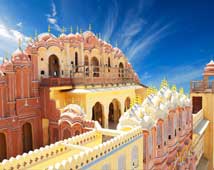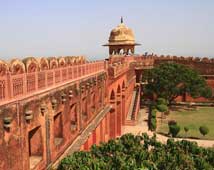
Jaipur the capital city of the northern Indian state of Rajasthan is one of the most vibrant and colourful cities of India. Famous for its colourful culture, forts, palaces, and lakes the city basks in the glory of a rich and eventful past. Jaipur is a planned city which is made all the more attractive by the pink wash that most buildings are periodically given.
Besides, it remains the only city in the world that symbolises the nine divisions of the universe, through nine rectangular sectors. It is for these reasons that Jaipur has been included on the popular tourist "Golden Triangle" of Delhi-Jaipur-Agra.
The sprawling palace of Sawai Jai Singh II, sits right in the centre of the geometric grid in the heart of the old city. It consists of the seven-storied Chandra Mahal, Mubarak Mahal, the Diwan-i-Am and the Diwan-i-Khas. While the beautiful Chandra Mahal is still used as a residence by the former royal family, a part of the complex is open to the public as the City Palace Museum. The City Palace Museum houses an exquisite collection of textiles, costumes, carpets, the finest porcelain and a rare collection of arms and paintings. It is here that you can see the world’s largest silver objects - a pair of giant urns.
The fort-palace Amber, 11 km from Jaipur is a fascinating blend of Hindu and Muslim architecture. Built in the 16th and early 17th centuries by Raja Man Singh and his successor Jai Singh I, it sprawls dramatically on a hillside overlooking the Maotha Lake. The white marble and red sandstone complex has some interesting apartments of a kind found nowhere else. The stunning Sheesh Mahal in the Jai Mandir, the Jas Mandir, Sukh Niwas and the shimmering gateway Ganesh Pol, justify the ten-minute climb up the hill. The less energetic can make the journey riding a caparisoned elephant, in the manner of former kings and queens.

Hawa Mahal or the ‘Palace of Winds’ is one of the most unusual structures built by Maharaja Sawai Pratap Singh. Honeycombed with over 900 niches or windows, it allowed the ladies of the court to watch the activities on the streets below and yet not be seen themselves! The Hawa Mahal too is made of the famed Jaipur pink stone!
is one of the five observatories built by Sawai Jai Singh whose ruling passion was astronomy. It was built between 1728-34 and consists of observer’s seat, sundial and a number of enormous instruments used to calculate altitude, locate and identify celestial bodies. These instruments are extremely accurate.
Two forbidding forts, Nahargarh and Jaigarh, tower above Jaipur and the old capital, Amer, in the north. Nahargarh Fort (or Tiger Fort) is 2 km from Jaipur was once a royal retreat for the Maharanis (queens) and was also used as a personal treasury. Legend has it that a huge treasure of gold bullion, jewels and gemstones is stashed away within its wall. Access to the fort is via a steep winding path. Once up in the fort premises, visitors can enjoy an excellent view of the city and sip a cup of tea/coffee at the RTDC caféteria.

Gaitor, the cremation ground of the rulers of Jaipur, nestling at the foot of the Nahargarh hills, has several ornate cenotaphs - Maharani ki Chattri, adorned by memorials to the royal ladies whose last rites were performed there. The imposing Jaigarh, or the Fort of Victory, built by Sawai Jai Singh in 1726 stands sentinel over Amber. It housed the royal treasury for many years. The piece-de-resistance here is Jai Vana, believed to be the world’s largest cannon on wheels (barrel length 6m or 20 ft).
Sisodia Palace and Garden is the 18th century palace with a terraced well laid garden where there are several galleries, pavilions and beautiful murals depicting scenes from the life of Lord Krishna.The Jal Mahal is a lovely palace/hunting lodge set in the Man Sagar Lake, used for duck-shoots by the royalty.